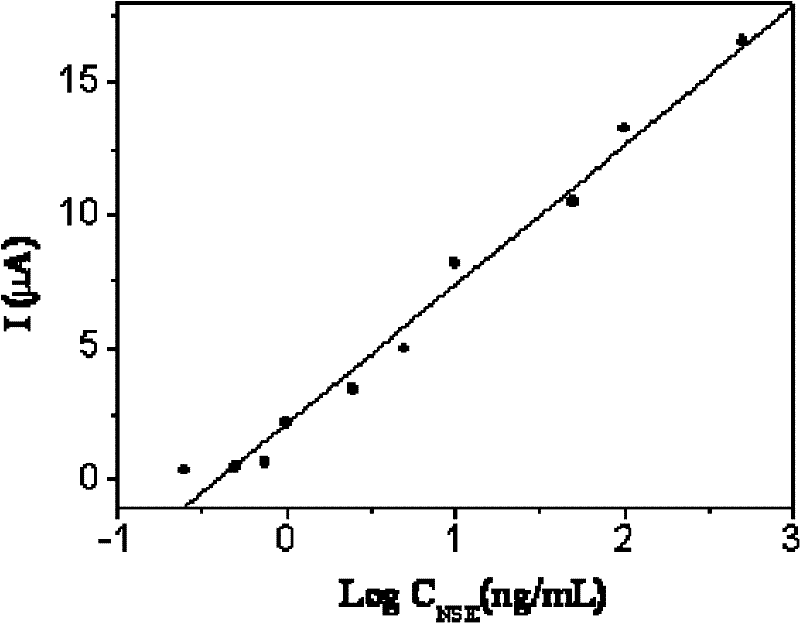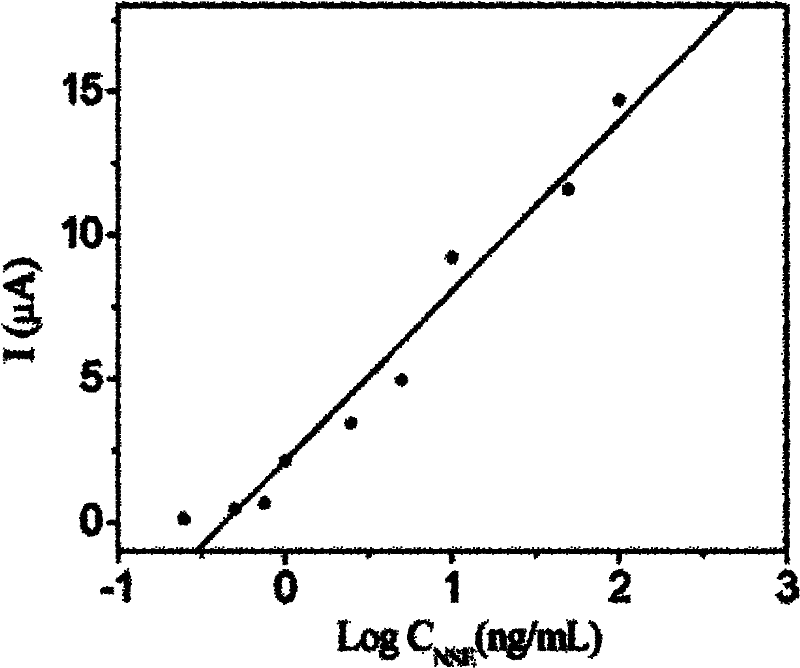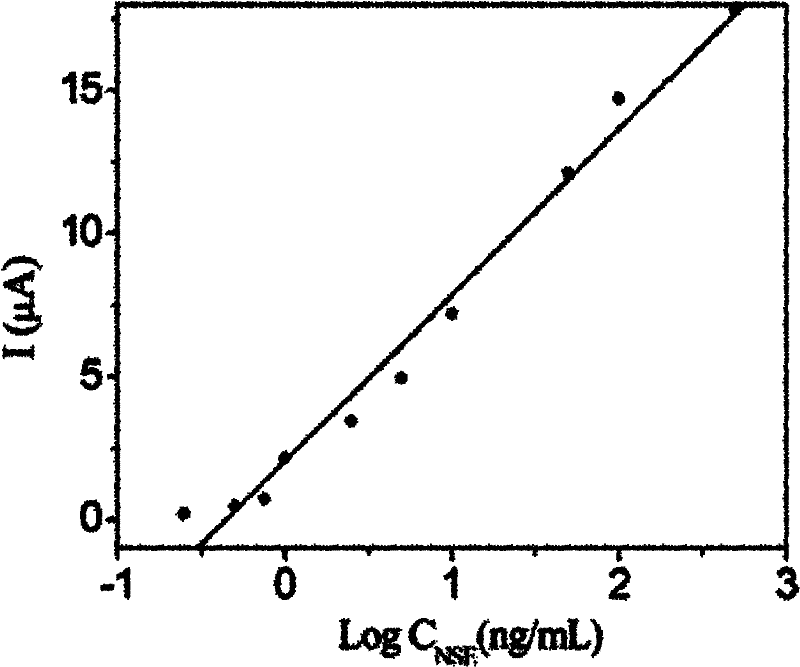Electrochemical immunoassay method based on Au-PB-SiO2 composite nano-particles
A technology of composite nanoparticles and immunoassay method, which is applied in the field of electrochemical immunity, can solve the problems affecting the accuracy of small cell lung cancer, the sensitivity of enzyme-linked immunoassay is not high, and it is difficult to detect trace neuron-specific enolase.
- Summary
- Abstract
- Description
- Claims
- Application Information
AI Technical Summary
Problems solved by technology
Method used
Image
Examples
Embodiment 1
[0061] Embodiment 1 prepares Au-PB-SiO 2 composite nanoparticles
[0062] Add 2 mL of tetraethyl orthosilicate (TEOS) into a mixed solution of 10 mL of ethanol and 23 mL of double distilled water, sonicate, mix well, add dropwise 5 mL of 25% ammonia solution, keep stirring at 30°C for 2 h, and centrifuge at 6000 rpm for 15 min. The supernatant was discarded, and the collected precipitate was washed with ethanol and deionized water until the pH value was neutral, and the SiO-containing 2 solution of nanoparticles; FeSO with a molar ratio of 1:5 4 and K 3 Fe(CN) 6 added to the SiO-containing 2 In the solution of nanoparticles, keep stirring at room temperature for 12h, centrifuge at 6000rpm for 20min, discard the supernatant, collect the precipitate and wash it with ethanol and deionized water respectively to obtain the PB-SiO 2 solution of nanoparticles; to the containing PB-SiO 2 Add N-(β-aminoethyl)-aminopropyltriethoxysilane (APTES) solution to the solution of nanopart...
Embodiment 2
[0063] Example 2 Preparation of Au-PB-SiO 2 composite nanoparticles
[0064] Add 2 mL of tetraethyl orthosilicate (TEOS) into a mixed solution of 10 mL of ethanol and 23 mL of double distilled water, sonicate, mix well, add dropwise 5 mL of 25% ammonia solution, keep stirring at 30°C for 2 h, and centrifuge at 6000 rpm for 15 min. The supernatant was discarded, and the collected precipitate was washed with ethanol and deionized water until the pH value was neutral, and the SiO-containing 2 solution of nanoparticles; FeSO with a molar ratio of 1:5 4 and K 3 Fe(CN) 6 added to the SiO-containing 2 In the solution of nanoparticles, keep stirring at room temperature for 12h, centrifuge at 6000rpm for 20min, discard the supernatant, collect the precipitate and wash it with ethanol and deionized water respectively to obtain the PB-SiO 2 solution of nanoparticles; to the containing PB-SiO 2 Add N-(β-aminoethyl)-aminopropyltriethoxysilane (APTES) solution to the solution of nanop...
Embodiment 3
[0065] Example 3 Preparation of Au-PB-SiO 2 composite nanoparticles
[0066] Add 2 mL of tetraethyl orthosilicate (TEOS) into a mixed solution of 10 mL of ethanol and 23 mL of double distilled water, sonicate, mix well, add dropwise 5 mL of 25% ammonia solution, keep stirring at 30°C for 2 h, and centrifuge at 6000 rpm for 15 min. The supernatant was discarded, and the collected precipitate was washed with ethanol and deionized water until the pH value was neutral, and the SiO-containing 2 solution of nanoparticles; FeSO with a molar ratio of 1:5 4 and K 3 Fe(CN) 6 added to the SiO-containing 2 In the solution of nanoparticles, keep stirring at room temperature for 12h, centrifuge at 6000rpm for 20min, discard the supernatant, collect the precipitate and wash it with ethanol and deionized water respectively to obtain the PB-SiO 2 solution of nanoparticles; to the containing PB-SiO 2 Add N-(β-aminoethyl)-aminopropyltriethoxysilane (APTES) solution to the solution of nanop...
PUM
 Login to View More
Login to View More Abstract
Description
Claims
Application Information
 Login to View More
Login to View More - R&D
- Intellectual Property
- Life Sciences
- Materials
- Tech Scout
- Unparalleled Data Quality
- Higher Quality Content
- 60% Fewer Hallucinations
Browse by: Latest US Patents, China's latest patents, Technical Efficacy Thesaurus, Application Domain, Technology Topic, Popular Technical Reports.
© 2025 PatSnap. All rights reserved.Legal|Privacy policy|Modern Slavery Act Transparency Statement|Sitemap|About US| Contact US: help@patsnap.com



